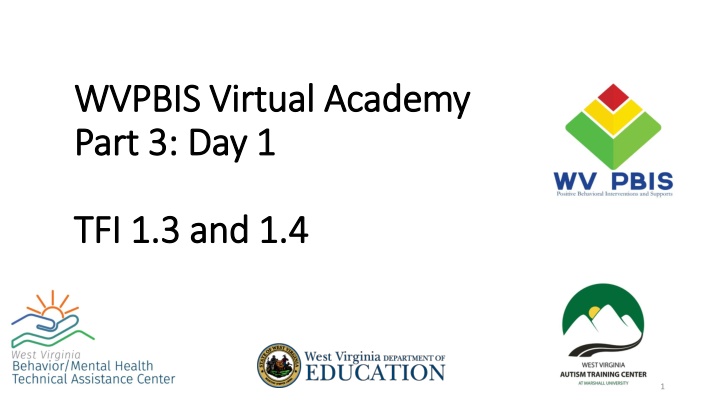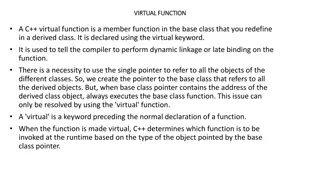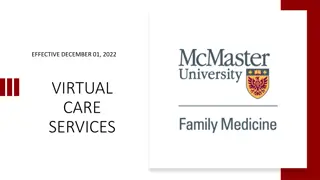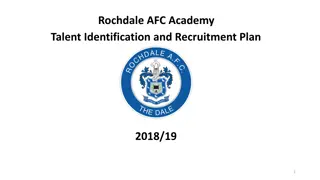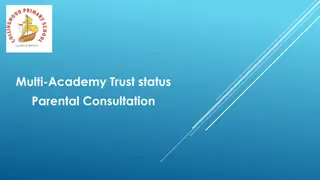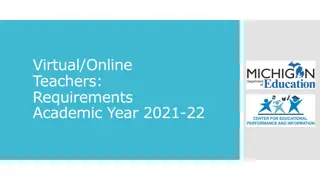WVPBIS Virtual Academy
Create a positive school environment by defining and teaching clear behavioral expectations to students and staff. Establish 3-5 broad, positively stated behaviors for safety, respect, and responsibility. Encourage behaviors like accountability, kindness, and leadership. Avoid negative examples and strive for consistency throughout campus settings.
Download Presentation

Please find below an Image/Link to download the presentation.
The content on the website is provided AS IS for your information and personal use only. It may not be sold, licensed, or shared on other websites without obtaining consent from the author.If you encounter any issues during the download, it is possible that the publisher has removed the file from their server.
You are allowed to download the files provided on this website for personal or commercial use, subject to the condition that they are used lawfully. All files are the property of their respective owners.
The content on the website is provided AS IS for your information and personal use only. It may not be sold, licensed, or shared on other websites without obtaining consent from the author.
E N D
Presentation Transcript
WVPBIS Virtual Academy WVPBIS Virtual Academy Part Part 3: 3: Day Day 1 1 TFI TFI 1.3 and 1.4 1.3 and 1.4 1
Attendance Check the Chat Box for a Link
Todays Objectives TFI 1.3 Behavioral Expectations School has five or fewer positively stated behavioral expectations and examples by setting/location for students and staff behaviors (ie., school teaching matrix) defined and in place. TFI 1.4 Teaching Expectations Expected academic an d social behaviors are taught directly to all students in classrooms and across other campus settings/locations. 4
Behavioral Expectations 1.3 Behavioral Expectations
The Ideal Student What does an Ideal Student look like in your school? Examples: Student a. Speaks out if others are bullied b. Asks for help to understand an assignment
Why Should We Establish School-wide Behavioral Expectations?
Tier 1 Expectations Should Be Broad and positively stated behaviors that are easy to remember (select 3-5) Be Safe Be Respectful Be Responsible Demonstrated by all staff, students, and family in all settings Cafeteria Hallway Bathroom Office etc. Posted throughout campus Consistent with school s mission statement (you may need to change your mission statement)
T H E DO NOTs (A Non-Example)
(Another Non- Example)
Behavioral Expectation Examples Be Respectful Be Responsible Be Safe Be Ready Be Kind Be Organized Be On Time Be a Leader Be Prepared Accountability Dedication Honesty Optimism Determination Excellence
Examples of School-wide Expectations from West Virginia Schools Chandler Academy
Glad Elementary
Coalton Elementary
Triadelphia Middle
Common Mistakes Making it cute Negatively stated Connecting with school mascot if it doesn t connect Combing with other initiatives Making it too difficult Not able to compromise or come to a consensus (too many cooks in the kitchen) Not getting staff and student input Not looking at your data
The Ideal Student Activity Building the Core (See Handout) Helps build consensus among staff, students and families Brainstorm ideas to inspire change in students & staff Identify 3-5 broad expectations, define critical attributes
Fair Process for Buy-In People are happier, more cooperative and productive, and more likely to make positive changes in behavior when those in authority do things with them, rather than to them or for them."
Empowering Staff and Students How do we want to treat each other? What s expected of me? And why?
Create a School-wide Behavioral Expectation Matrix
Why Create A Matrix? The learning environment becomes SAFE, PREDICTABLE, and POSITIVE. a It can be easily shared with staff, students, & families. a This can STILL make learning, even virtually, more EFFECTIVE. We can t assume that kids should know how to behave.
When and How to Teach Behavioral Expectations? Kick-off Events Beginning, mid-year and after holiday breaks On-going Direct Instruction Classroom Lesson Plans Pre-correction or Re-teaching immediately after behavioral errors Videos Making sure they are data driven Students should demonstrate the positive examples only Ensure students involved are representative of your student body Booster Trainings Scheduled and data-driven Continued Visibility Visual Displays posters, agenda covers, t-shirts Daily announcements Newsletters
Teach in Context in the cafeteria in the restrooms
Remote Learning Matrix Example
Resource Manual PBIS.org
Integrating Social-Emotional Competencies in your Teaching Matrix https://www.pbis.org/Common/Cms/files/pbisresources/TeachingSocialEmotionalCompetenciesWithinAPBISFramework.pdf
SETTING Teaching Matrix Library/ Computer Lab Hallways Cafeteria Bus Classroom Keep hands feet and other objects to self Eat only your food Study, read, compute Watch for your stop Be Respectful Expectations Push in chairs. Treat books carefully. Wipe your feet Sit appropriately Replace trays & utensils Be Responsible Use quiet voice Maintain your own physical space Stay to the right Use a quiet voice Stay in your seat Clean up your eating area Whisper. Return books Be Safe Supervise students until all enter cafeteria Instruct from back to keep eyes on all screens Ensure students enter bus calmly Stand in hall during passing periods Conditions for Learning
Homework Assignment (See Webinar) Creating Your Tier 1 School-wide Behavioral Expectation Matrix Due Date South: Friday, October 16, 2020 North: Friday, October 23, 2020
Questions?? Day 2 Feedback/Acknowledgement (1.9) Discipline Systems (1.5 and 1.6) Data (1.12 and 1.13) Day 2 South- October 20th, 21st and 22nd Day 2 North-October 27th, 28th and 29th
Teryl Jones, MA Behavior Support Specialist joneste@marshall.edu (740) 307-3191
